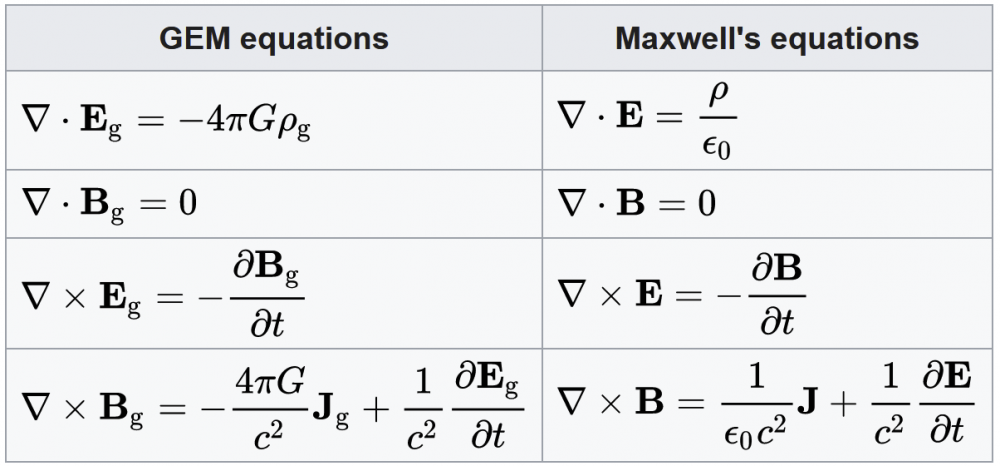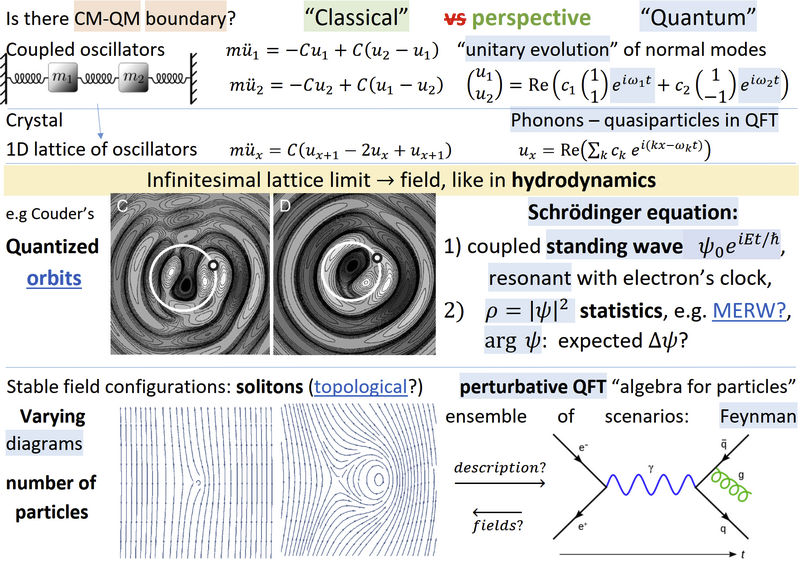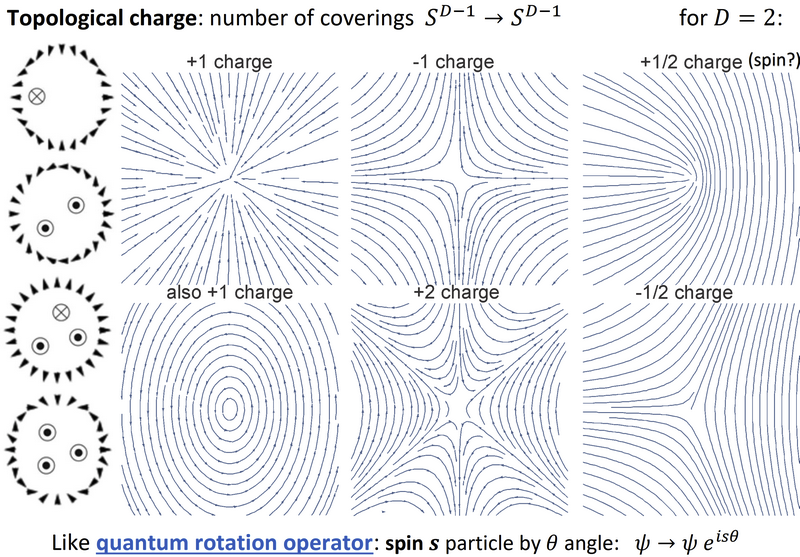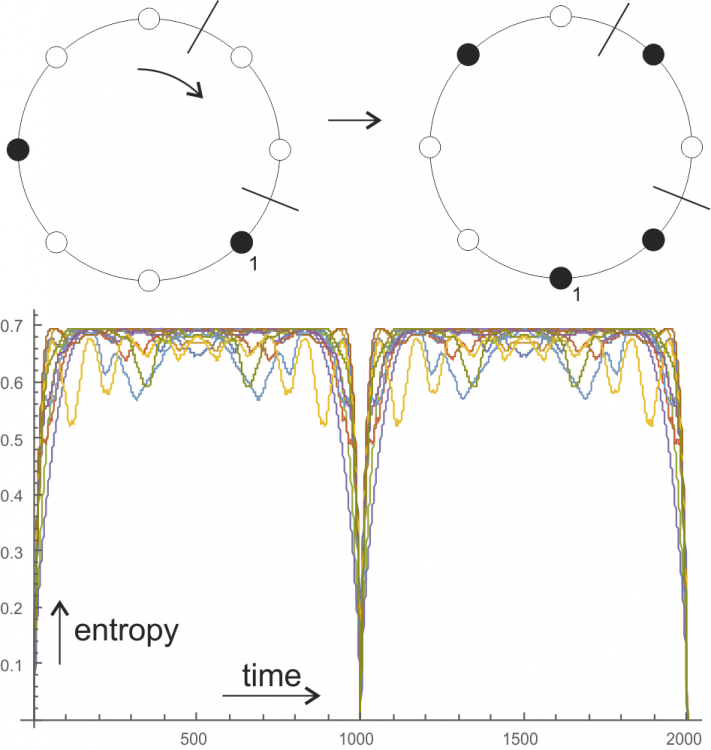

Duda Jarek
Senior Members-
Posts
587 -
Joined
-
Last visited
Content Type
Profiles
Forums
Events
Everything posted by Duda Jarek
-

What does it mean that physics it time/CPT symmetric?
Duda Jarek replied to Duda Jarek's topic in Physics
Regarding baryon asymmetry, I would say it is statistical symmetry breaking: that symmetric situation is statistically repelling. Like for e.g. L-amino acids in our life: while there is symmetry, the more one type of them, the easier development of life based on the same (more resources in environment) - making 1/2-1/2 ration statistically repelling, leading to nearly complete domination of one of them - originally chosen e.g. in a random way. For baryon asymmetry we don't need CPT violation, it is sufficient to have this kind of statistical repelling. For example that in baryogenesis: "creation of proton is a bit more likely in presence of electron" plus symmetric "creation of antiproton is a bit more likely in presence of positron" such two symmetric rules would make 1/2-1/2 ratio matter-antimatter state statistically repelling, leading to nearly complete domination of one of them, e.g. initially chosen in a random way. -

What does it mean that physics it time/CPT symmetric?
Duda Jarek replied to Duda Jarek's topic in Physics
For the scattering matrix as S_fi = <fin| S |in> it is good to see it as one amplitude being a result of propagator from -infinity time, second from +infinity, and S as propagator between them. This time-symmetric view is called TSVF: https://en.wikipedia.org/wiki/Two-state_vector_formalism This way we get Born rule from time-symmetry, what also works if asking for probability distribution inside sequence from Ising model: using spatial symmetry instead of temporal, Boltzmann path ensemble instead of Feynman: Sure there is - what Gravity Probe B has directly tested is gravitoelectromagnetism approximation of general relativity, which is second: gravitational set of Maxwell's equations (necessary to make Newton force Lorentz invariant): https://en.wikipedia.org/wiki/Gravitoelectromagnetism Frame dragging, Lense-Thirring effects are gravitational analogues of Lorentz force ( https://en.wikipedia.org/wiki/Lense–Thirring_precession ). Kepler problem with such correction simulator: https://demonstrations.wolfram.com/KeplerProblemWithClassicalSpinOrbitInteraction/ In hydrodynamics, Coriolis force corresponds to Lorentz force, see e.g. https://www.pnas.org/content/107/41/17515 -

What does it mean that physics it time/CPT symmetric?
Duda Jarek replied to Duda Jarek's topic in Physics
@joigus, time ordering is required for performing calculations, but just to understand time/CPT symmetry it is sufficient to imagine e.g. history of the Universes as the result of ensemble of all possible Feynman diagrams throughout this history ... for unification with general relativity it should include ensemble of shapes of spacetime, what leads to infinity which is too large for standard renormalization techniques. Regarding topology, I usually use the below diagram: Coupled pendula can be defined through "classical" evolution, but we can also go to normal modes where evolution becomes just rotations - "unitary/quantum". Then we have lattice of pendula e.g. as crystal, its normal modes are plane waves ... and in QFT are treated as real particles - phonons. The difficulty comes with the continuous limit, but there are many hydrodynamical QM-like phenomena (like Casimir, Aharonov-Bohm, interference, tunneling, orbit quantization) - slides with links: https://www.dropbox.com/s/kxvvhj0cnl1iqxr/Couder.pdf For varying number of particles we use QFT, but we should be able to also ask for e.g. EM configuration behind each Feynman diagram, e.g. with nearly singularity for charge. In this picture particles are localized field configurations: solitons, e.g. topological for spin/charge quantization, for their effective description we still need ensemble of scenario - perturbative QFT. Soliton particle models are slowly getting to mainstream e.g. https://journals.aps.org/prl/abstract/10.1103/PhysRevLett.121.232002 Many these models of particles e.g. Penrose twisters work in this soliton picture, or e.g. from superfluid/superconductor very topological picture e.g. from Volovik's "The Universe in Helium droplet" - if somebody is interested, in 90 minutes we have online talk about it: http://th.if.uj.edu.pl/~dudaj/QMFNoT -
I don't know what it has to do with time, but here is a great list: https://en.wikipedia.org/wiki/List_of_fractals_by_Hausdorff_dimension Its two most complex formulas come from my https://demonstrations.wolfram.com/TheBoundaryOfPeriodicIteratedFunctionSystems/
-

What does it mean that physics it time/CPT symmetric?
Duda Jarek replied to Duda Jarek's topic in Physics
Lorentz invariance says that intuition of "objective time direction", "current situation" (hyperspace of constant time) are wrong - they literally change with velocity of observer. So it says something about time, but at most time symmetry (as in the CPT theorem requiring it for QFT), but special/general relativity alone don't need to combine it with P, they don't see charge C. Topological charge is great to understand spin/charge quantization, e.g. defining EM field as curvature of some vector field, Gauss law counts winding number/topological charge which has to be integer (Gauss-Bonnet theorem) - we get electromagnetism with built-in charge quantization (Faber's model, slides with links: https://www.dropbox.com/s/aj6tu93n04rcgra/soliton.pdf ). While they are P, T symmetric, the C symmetry changes the situation: -

What does it mean that physics it time/CPT symmetric?
Duda Jarek replied to Duda Jarek's topic in Physics
Personally I don't think wormholes are realized in nature, but assuming general relativity is true, in theory it allows for non-orientable spacetime, so such possibility needs to be included in considerations. And it gives very valuable thought experiment - for better understanding of nature of time. Another question is if there are possible CPT analogues of any phenomena? For example of laser - which stimulated emission causes excitation of target later. Is CPT analogue of laser possible? If so, shouldn't its stimulated absorption cause deexcitation of (constantly excited like lamp) target earlier? For free electron laser building its CPT analogue seems quite straightforward ... -

What does it mean that physics it time/CPT symmetric?
Duda Jarek replied to Duda Jarek's topic in Physics
General relativity at least in theory allows to directly perform T symmetry by non-time-orientable spacetime. For example imagine wormhole which glues like in Klein bottle - traveling through it should apply T or P symmetry. -

What does it mean that physics it time/CPT symmetric?
Duda Jarek replied to Duda Jarek's topic in Physics
While P and T symmetries are rather global, in theory we can make C locally: changing just one charge ... but it would switch direction of all Coulomb forces for it, making it a bit different situation - it seems the safest to think of all 3 CPT as global (?) ps. slides with links, diagrams (e.g. Wheeler, delayed choice): https://www.dropbox.com/s/0zl18yttgnpc52w/causality.pdf -

What does it mean that physics it time/CPT symmetric?
Duda Jarek replied to Duda Jarek's topic in Physics
Renormalization is mathematical trick to ignore infinities, e.g. of infinite energy of electric field of point charge (which seem not to have experimental basis) - it indeed works locally. But what do you mean that CPT symmetry is only local? It consists of C symmetry which indeed can be seen local, but how to imagine P and T symmetry as local? Considering scattering e.g. of topological solitons, we also need ensemble of scenarios: Feynman diagrams, but I cannot imaging how P, T symmetry could be local? -

What does it mean that physics it time/CPT symmetric?
Duda Jarek replied to Duda Jarek's topic in Physics
There is no entropy in this fundamental level like QFT (it is zero). For entropy we need to get to effective picture, like replacing positions of particles with densities - what is kind of mean field approximation. Fundamental symmetries can be violated on the level of solution, like throwing a rock to symmetric lake surface. Assuming there is a (time/CPT symmetric) tendency for entropy growth, low entropic Big Bang should cause 2nd law of thermodynamics. We know that Big Bang had low entropy, need to understand why - a natural explanation is that because everything was localized(?) -

What does it mean that physics it time/CPT symmetric?
Duda Jarek replied to Duda Jarek's topic in Physics
CPT symmetry is not limited to single particle, cannot we transform any Feynman diagram this way? Couldn't we imagine decomposition of the History of the Universe into Feynman diagrams and applying CPT symmetry to all of them? Regrading entropy, this is effective picture - having some concrete configuration of particles, there is no entropy (it is zero) ... To get entropy we need to go to statistical picture by some smoothing, mean field approximation - in which there is entropy and it has a general tendency to grow ... and this tendency might be time symmetric (?) Related question: under hypothetical assumption that our Universe will finally collapse (true or not), what should be entropy of such Big Crunch? Entropy should depend on situation (densities, energies) in a given moment - isn't Big Bang and Big Crunch similar from entropy perspective? "Proofs" of entropy growth e.g. of Boltzmann H-theorem for time symmetric systems seem a nonsense (we could also prove entropy growth after time symmetry - contradiction) - they always use some uniformity assumption "stoßzahlansatz", kind of mean field approximation. It is nicely seen in this this trivial Kac ring model - just dots on ring rotating by one position per time unit, switching color if crossing marked position (diagram below). It is time symmetric, we can "prove" entropy growth using such assumption (percentage of white balls = percentage of white balls before marked position). However, we can also have cyclic evolution of entropy (all white balls after 2n steps are again all white balls): https://pdfs.semanticscholar.org/aa48/764e372033dcd45feb8f487a3d10e2420088.pdf -
Time/CPT symmetry is at heart of many models of physics, like unitary evolution in quantum mechanics, or Lagrangian formalism we use from classical mechanics, electromagnetism, up to general relativity and quantum field theories. In theory we should be able to decompose any scenario (history of the Universe?) into ensemble of Feynman diagrams, apply CPT symmetry to all of them, getting CPT analogue of entire scenario (?) There are many QM-based experiments which kind of use time symmetry (?), for example (slides with links) : Wheeler experiment, delayed choice quantum eraser (DCQE), “asking photons where they have been”, “photonic quantum routers”, Shor algorithm as more sophisticated DCQE. However, this symmetry is quite nonintuitive, very difficult to really accept – mainly due to irreversibly, thermodynamical counterarguments (are there other reasons?) Can e.g. this conflict with 2nd law of thermodynamics be resolved by just saying that symmetry of fundamental theories can be broken on the level of solution, like throwing a rock into symmetric lake surface? Are all processes reversible? (e.g. wavefunction collapse, measurement) So is our world time/CPT symmetric? What does it mean? Personally I interpret it that we live in 4D spacetime, (Einstein's) block universe/eternalism: only travel through some solution (history of the universe) already found in time/CPT symmetric way, like the least action principle or Feynman path/diagram ensemble - is it the proper way to understand this symmetry? Are there other ways to interpret it?
-
Over a million doses of Oxford/AstraZeneca coronavirus vaccine possible by September, says researcher https://www.reuters.com/article/us-health-coronavirus-oxford-vaccine-res/over-a-million-doses-of-oxford-astrazeneca-covid-19-vaccine-possible-by-september-researcher-idUSKCN24L1TW Also two more Phase III (to 6 + 1 approved) in https://www.nytimes.com/interactive/2020/science/coronavirus-vaccine-tracker.html
-
https://www.nejm.org/doi/full/10.1056/NEJMoa2022483 General optimism and preparation for vaccine this December:
-
There was added "approved" on this vaccine tracker ... for military use, also in phase II:
-
The problem with getting quadrupole is that it requires at least two charges in a distance, while (ignoring quarks) we have only one - here it is explained by "proton bilocation", while it seems nobody considers (believes?) in quarks in nuclear physics level (? why?). I didn't say anything about electron's trajectory, |pn with electron seeing pn> can be treated e.g. with Schrodinger.
-
To get quadrupole, proton in these two cases ('pn' and 'np') needs to be in a bit different places (shifted by ~fm). Electron in orbital interacts with proton e.g. through Coulomb, for which there is a tiny difference between these two cases - they are distinguishable for electron in orbital. Not true? You can says that we have superposition " |pn with electron seeing pn> - |np with electron seeing np> ", but in this case such electron doesn't see quadrupole - which seems required in deuteron-based atoms.
-
Ok, let us see deuteron as "|np> - |pn>" to get quadrupole moment. Measuring proton's position, we would get pn or np ... but having electron in orbital, wouldn't it "measure" proton's position through EM interactions as there is slight difference between pn and np? Ok, we can say we have superposition:" |pn with electron seeing pn> - |np with electron seeing np> ", but would such electron see quadrupole this way? Here is some paper with deuteron based atoms, and they consider quadrupole: https://www.researchgate.net/profile/Nir_Nevo_Dinur/publication/263316174_Improved_estimates_of_the_nuclear_structure_corrections_in_mD/links/543ce7860cf2c432f7422a6b/Improved-estimates-of-the-nuclear-structure-corrections-in-mD.pdf Regarding charge shift, imagining deuteron as 6 quarks/charges - calculating e.g. Schrodinger equation for 6 charges and averaging, you would also see repulsion in statistics - shifting away charges as in quadrupole. So this is in fact question if quarks take part in nuclear binding, e.g. by some (statistical?) shifts to reduce energy. Currently for e.g. deuteron-proton or neutron scattering, there are fitted ~40 parameters models including 3-body forces ( https://en.wikipedia.org/wiki/Three-body_force ) and neglecting quark structure - we could fit anything for modelling 3 nucleons with 3-body forces. Why not try to go toward quarks to understand nuclear binding? Would we still need 3-body forces in this case?
-
Exactly - this dynamical approach to explain qudrupole moment in 'pn' with angular momentum is quite controversial if thinking about it. So the question is: why not consider static instead? Seeing deuteron as (among others) 6 quarks, e.g. minimization of Coulomb energy says positive (fractional) charges should have tendency to shift far apart - as in quadrupole. Can we distinct experimentally these two possibilities: angular momentum explanation from e.g. quark-level shift of charge from proton to neutron?
-
The current explanation of this quadrupole moment using angular momentum is that single proton is simultaneously on both sides of neutron: This probability cloud means that if being able to measure position of proton, we should get 1/2 - 1/2 statistics. Doesn't it mean that there is some 'pn' - 'np' oscillation?
-
From https://www.nytimes.com/interactive/2020/science/coronavirus-vaccine-tracker.html , third vaccine has entered phase III:
-
https://www.nytimes.com/interactive/2020/science/coronavirus-vaccine-tracker.html Phase III: 2 Phase II: 8 e.g. Moderna to start Phase III in July, Phase I: 10 Preclinical: 125+
-
Naively we have proton-neutron with only proton charged - shouldn't it have electric multipoles as proton: zero electric dipole and quadruple moment? Quadrupole moment grows with square of distance, to get 0.2859 e fm^2 for deuteron, e.g. spitting its charge into 1/2 - 1/2 e they would need to be in ~0.76 fm distance. How could we get such charge distance for 'pn'? Thinking about it as 6 quarks it seems more doable (?) ps. However, I have seen some papers claiming nontrivial structure of charge in neutron (?): positive core, negative shell, e.g. https://inspirehep.net/literature/1377841 http://www.actaphys.uj.edu.pl/fulltext?series=Reg&vol=30&page=119 http://www.phys.utk.edu/neutron-summer-school/lectures/greene.pdf






